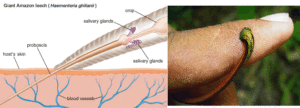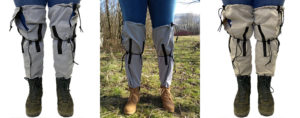Leeches – All About Leeches – How to Remove a Leech and How to Protect Yourself
1) What are leeches and where are they found?
Leeches are segmented worms – a bit like giant earth worms. Most leeches live in fresh water environments but some species can be found in sea water and in terrestrial environments. They are quite common in tropical rain forests in South America and South East Asia where they live in leaf litter and vegetation.
2) What do leeches look like?
Leeches can vary in length from a few millimetres to 10 or 20cm – and of course they get bigger as they feed…

3) So what’s the problem with leeches?
Most leeches prey on small invertebrates but some species like to feed on blood – and if they happen to come across a human being they’ll think it’s Christmas, with no fur or feathers or scales or anything else to get in the way – just naked skin with warm blood pulsating below, just a single bite away…
4) How do leeches find you?
Leeches find their prey by using a combination of olfactory sensors (chemical and smell detectors) and movement and vibration sensors. Consequently, they can both ‘smell’ and ‘feel’ you coming, and if you stand still for a few minutes in a leech infested area you may see them dropping from vegetation and inching towards you.
5) How do leeches bite you and attach themselves to you?
Leeches use their suckers (one at each end of their body) to manoeuvre into position and then attach themselves by biting their victim. The bite is usually painless because they release an anesthetic to prevent the host from feeling them, thereby reducing the likelihood of discovery. Once attached they also release an anticoagulant into the host’s bloodstream to keep the blood flowing whilst they feed. If they are left alone they will detach themselves and depart after they have finished feeding, which could take anywhere from 20 mins to 2 hours or more.

6) How can I remove a leech that has already started feeding?
Firstly – what you shouldn’t do – don’t just rip it off. If the mouth parts of the leech are firmly attached you may leave them behind in the wound, thereby increasing the risk of the wound becoming infected.
Secondly – what isn’t recommended – it’s quite easy to remove a leech by applying a flame, a lit cigarette, salt, soap or a chemical such as alcohol, vinegar, lemon juice or insect repellent. The leech will detach itself quite quickly but it’s also likely to regurgitate some of the contents of its stomach into the wound in its haste, thereby increasing the risk of the wound becoming infected.
Thirdly – the recommended technique:
– identify the oral sucker at the anterior (mouth end) of the leech – generally this is the thinner end of the leech
– put your finger or some other flat, blunt object on the skin adjacent to the oral sucker and then slide it under the sucker to break the seal, at which point the leech will detach its jaws
– repeat the process with the sucker at the posterior (rear end) of the leech – generally this is the thicker, bloated end of the leech. Take care to ensure that the leech doesn’t reattach itself at the other end!
– clean the wound and bandage it. Bleeding may continue for some time because of the anticoagulant – it could be anything from a few hours to a few days. The wound normally itches as it heals and care should be taken not to scratch it, thereby increasing the risk of infection.
7) Are leech bites dangerous?
Generally no – leeches often carry parasites in their digestive tracts but they can’t survive in humans and hence they don’t pose a threat. Very rarely though leeches have been known to pass on disease from one human to another that’s carried in the blood they have consumed. The biggest risk is from infection in the wound after the leech has dropped off or been removed, so the wound should always be cleaned and bandaged.
8) How can I stop myself getting bitten by a leech?
This is one of the most important questions because prevention is always much better than cure:
– Be aware – know where to expect leeches so that you know when to take precautions to protect yourself.
– Cover up – wear long sleeved tops and long trousers, and tuck your trouser legs into your socks. Wearing gaitors, leech proof over socks and insect repellent clothing can also help enormously.
– Use an insect repellent – insect repellent can help to protect any exposed areas. Clothing can also be treated with LifeSystems EX4 permethrin clothing spray to make it insect repellent.
________________________________________________________________________________________________________________
How to avoid Leeches and protect yourself with Leech proof socks
Sorry to say yes, there is such a thing and yes, it could happen during your travels: if you’re headed to a rainforest or to a hot and moist natural destination, do NOT leave your leech socks at home.
Tropical rainforests are wonderful environments. But, the wetter the weather, the hungrier leeches get for your flesh, a fact most tourism boards and travel agencies will underplay.
You won’t only find leeches in rainforests, you’ll also find them in other warm and wet places – lakes, marshes, ponds and the like.
There are many ways of protection and buying anti-leech socks is the most obvious and the easiest.
But there are ways to do more to prevent leeches preying on your skin.

– Wear lighter colors so you can spot them more easily. If they do fall on you, you can immediately brush them away before they attach themselves to you if they find a gap through your clothes.
– Assume that any stagnant water has leeches so don’t let the water come into contact with your skin. Leech socks will prevent them from coming into contact with your skin.
– Tuck all your clothes in: roll down your sleeves, tighten your cuffs and do up your collar area. Leeches can wriggle into the tiniest gaps and are quite small – until they’ve feasted on you, that is. Leeches love delicate skin, like armpits and genitals, so tuck in your trouser bottoms as well.
– Use a Permethrin clothing spray to maximise the effectiveness of your leech protection socks. Spray them with permethrin for clothes and don’t forget to spray your clothes and boots while you’re at it. This should kill the leech before it starts feasting on you.
– Apply insect protection directly to your body. In addition, if you’re seriously concerned you can also apply DEET insect repellents.

Can leeches bite through clothes?
If you’re spraying your own clothes with any kind of mosquito or leech repellent, remember that leeches can push looser weaves apart to get to their meal.
And if you happen to put your backpack or jacket or anything on the ground in this kind of environment, check every corner for leeches before you put it back on!
So if you’re wondering, can leeches bite through leggings? The answer is, sometimes. If you happen to be wearing particularly thin or loose weave clothing, they may be able to get through to your skin.
How to remove a leech if one takes a liking to you
This is really the worst-case scenario but you should at least know how to do it. When visiting in Borneo for example, forest leeches are a constant concern. Clothing such as a hat, socks and every possible kind of insect-repellent clothing – is a must!
But if you forget your insect repellent trousers at home and one gets a hold of you, you’ll need to know how to handle it. So here’s how to get a leech off (bearing in mind we’re not doctors and that this is common advice you’ll find anywhere):
– Don’t panic. If the leech has been feeding on you, there will be some blood around. The leech feeds on you by pumping a kind of blood anticoagulant into your bloodstream. While that numbs the pain, it also makes you bleed quite a bit even after the leech is removed. Because of the painkiller, a leech could be feasting on you for quite some time before you notice. The wound can bleed for quite a while but it will stop. Don’t worry – you will not bleed to death.
– Work as a team. Since you’ll rarely be heading into the rainforest alone, a good strategy is to pick a “leech buddy”. Choose someone to watch your leeches for you – and you watch theirs. This way, at first alert, you’ll be able to brush it off.
– Encourage the leech to detach. There’s plenty of common wisdom about removing a leech: a lighter flame (ouch, this might hurt you as well as the leech), salt, alcohol, tobacco, your trusty mosquito spray and even spit. The problem with these methods is that the leech might throw up – into the wound, which could mean infection.
– Force the leech to detach. Some people will try to get rid of leeches by hand: gently slide sideways under the leech’s teeth by pushing a fingernail or other hard object under the leech’s sucker. If you succeed, quickly flick the beast off before it bites you again – because it will!
– After care of a leech bite. Once the leech is off, use clean paper towels to wipe the area and then disinfect it. Whatever you do, make sure that wound is CLEAN. Bear in mind that after the leech has been removed, you may continue to bleed for quite some time, even up to an hour or more. That’s normal. Watch your clothing and try to keep it out of the way, because –there will likely be lots of blood, enough to make you look like an extra in a zombie movie.

Leech Socks – How to wear them and what size is best?
The best recommendation is a pair of leech socks. Are you still wondering, what are leech socks? They are socks that are made from a tough, breathable synthetic fabric and cover your legs up to the knee. They will prevent any leech from getting in.
Leech repellent socks are a number one tip for preventing leech bites. Prevention is better than cure when it comes to these blood sucking creatures.
Leech Socks should be worn like a second pair of socks inside your boots and they pull right up over your trousers and above your knees. They can then be secured with a toggle and elastic draw cord both above and below your knees, thereby creating a continuous leech proof barrier.
The only time when size depends on height rather than shoe size!
Size Guide – the right size for you depends on your height, not your shoe size:
– Short – approx 20″ (51cm) long – suitable for children and adults up to about 5′ 6″ (1.68m) tall
– Medium – approx 22″ (56cm ) long – suitable for adults between about 5′ 6″ and 5′ 10″ (1.68m to 1.78m)
– Long – approx 24″ (61cm) long – suitable for adults taller than about 5′ 10″ (1.78m)
The size isn’t critical – it’s just a bit of a trade off between comfort and ease of use. The shorter they are, the more easily they stay up, although they may catch a bit at the back of your knees. The longer they are, the more likely they are to slip down a bit, but they’re less likely to catch at the back of your knees.
Don’t forget your Leech Socks!
If you’re travelling through a leech infested area there’s only one question you need to ask yourself really – Leech Socks or leeches crawling up your trouser legs? The choice is yours… Click on the link below when you know the answer!

